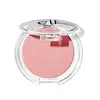What's inside
What's inside
 Key Ingredients
Key Ingredients

 Benefits
Benefits

No benefits
 Concerns
Concerns

 Ingredients Side-by-side
Ingredients Side-by-side

Hydrogenated Polyisobutene
EmollientHydrogenated Poly(C6-14 Olefin)
EmollientOctyldodecanol
EmollientIllite
AbrasiveTrimethylolpropane Triisostearate
EmollientBoron Nitride
AbsorbentTrimethylsiloxysilicate
EmollientC9-12 Alkane
SolventHydrogenated Styrene/Methylstyrene/Indene Copolymer
Alumina
AbrasiveDisteardimonium Hectorite
StabilisingPhenyl Trimethicone
Skin ConditioningSorbitan Sesquioleate
EmulsifyingPropylene Carbonate
SolventEthylene/Propylene/Styrene Copolymer
Triethoxycaprylylsilane
Ethylhexylglycerin
Skin ConditioningTin Oxide
AbrasiveButylene/Ethylene/Styrene Copolymer
Pentaerythrityl Tetra-Di-T-Butyl Hydroxyhydrocinnamate
AntioxidantAminopropyl Triethoxysilane
Tocopherol
AntioxidantRosa Damascena Flower Water
MaskingWater
Skin ConditioningRicinus Communis Seed Oil
MaskingSodium Hyaluronate
HumectantHydrogenated Castor Oil
EmollientHibiscus Mutabilis Flower Extract
Skin ConditioningPhenoxyethanol
PreservativeCI 77891
Cosmetic ColorantCI 45410
Cosmetic ColorantCI 19140
Cosmetic ColorantCI 15850
Cosmetic ColorantHydrogenated Polyisobutene, Hydrogenated Poly(C6-14 Olefin), Octyldodecanol, Illite, Trimethylolpropane Triisostearate, Boron Nitride, Trimethylsiloxysilicate, C9-12 Alkane, Hydrogenated Styrene/Methylstyrene/Indene Copolymer, Alumina, Disteardimonium Hectorite, Phenyl Trimethicone, Sorbitan Sesquioleate, Propylene Carbonate, Ethylene/Propylene/Styrene Copolymer, Triethoxycaprylylsilane, Ethylhexylglycerin, Tin Oxide, Butylene/Ethylene/Styrene Copolymer, Pentaerythrityl Tetra-Di-T-Butyl Hydroxyhydrocinnamate, Aminopropyl Triethoxysilane, Tocopherol, Rosa Damascena Flower Water, Water, Ricinus Communis Seed Oil, Sodium Hyaluronate, Hydrogenated Castor Oil, Hibiscus Mutabilis Flower Extract, Phenoxyethanol, CI 77891, CI 45410, CI 19140, CI 15850
Talc
AbrasiveTridecyl Trimellitate
EmollientMagnesium Stearate
Cosmetic ColorantMagnesium Palmitate
Sodium Potassium Aluminum Silicate
Zea Mays Starch
AbsorbentEthylhexyl Palmitate
EmollientDimethicone
EmollientPhenoxyethanol
PreservativeCaprylyl Glycol
EmollientPolyisobutene
Paraffinum Liquidum
EmollientMica
Cosmetic ColorantCI 77163
Cosmetic ColorantCI 77891
Cosmetic ColorantIron Oxides
CI 77007
Cosmetic ColorantCI 15850
Cosmetic ColorantCI 19140
Cosmetic ColorantCI 16035
Cosmetic ColorantTalc, Tridecyl Trimellitate, Magnesium Stearate, Magnesium Palmitate, Sodium Potassium Aluminum Silicate, Zea Mays Starch, Ethylhexyl Palmitate, Dimethicone, Phenoxyethanol, Caprylyl Glycol, Polyisobutene, Paraffinum Liquidum, Mica, CI 77163, CI 77891, Iron Oxides, CI 77007, CI 15850, CI 19140, CI 16035
 Reviews
Reviews

Ingredients Explained
These ingredients are found in both products.
Ingredients higher up in an ingredient list are typically present in a larger amount.
Ci 15850 is the pigment color red. It is an azo dye and created synthetically.
Azo dyes need to be thoroughly purified before use. This allows them to be more stable and longer-lasting.
This ingredient is common in foundations, lipsticks, and blushes. This color is described as brown/orangey red.
It has many secondary names such as Red 6 and Red 7. According to a manufacturer, Red 6 usually contains aluminum.
Learn more about CI 15850CI 19140 is also known as Tartrazine. Tartrazine is a synthetic dye used in cosmetics, foods, and medicine to add a yellow color.
Tartrazine is created from petroleum and is water-soluble.
Some people may experience allergies from this dye, especially asthmatics and those with an aspirin intolerance.
Learn more about CI 19140Ci 77891 is a white pigment from Titanium dioxide. It is naturally found in minerals such as rutile and ilmenite.
It's main function is to add a white color to cosmetics. It can also be mixed with other colors to create different shades.
Ci 77891 is commonly found in sunscreens due to its ability to block UV rays.
Learn more about CI 77891Phenoxyethanol is a preservative that has germicide, antimicrobial, and aromatic properties. Studies show that phenoxyethanol can prevent microbial growth. By itself, it has a scent that is similar to that of a rose.
It's often used in formulations along with Caprylyl Glycol to preserve the shelf life of products.